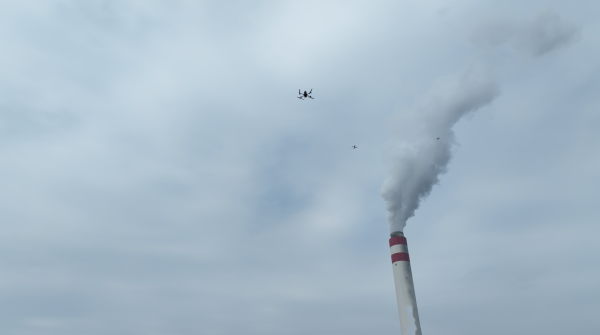China Builds Network to Track Human-Caused Carbon Emissions
China Builds Network to Track Human-Caused Carbon Emissions Mirage News


China Builds Network to Track Human-Caused Emissions
Introduction
In 2021, global anthropogenic CO2 emissions reached a staggering 40.0±2.9 billion tons. Managing anthropogenic emissions, especially from major industries, is crucial for addressing global warming and promoting sustainable growth.
The Importance of Transparent and Accurate Emission Records
However, existing emission records lack transparency and accuracy due to limited knowledge of CO2 emissions from cities and key sectors, leading to uncertainty in the global carbon budget.
The Low-cost UAV Coordinated Carbon Observation Network (LUCCN)
Recently, a research team led by Dr. YANG Dongxu from the Institute of Atmospheric Physics (IAP) of the Chinese Academy of Sciences has established the Low-cost UAV Coordinated Carbon Observation Network (LUCCN) equipped with medium-accurate greenhouse gas sensors for CO2 measurements. LUCCN combines ground-based and UAV-based in-situ measurement instruments, enhancing the detection and quantification capability of point source emissions in three dimensions.

The Need for an Adaptable Observation Network
“The existing and even near future satellite measurements cannot meet the frequent monitoring requirements for anthropogenic emissions due to cloud cover, aerosols, and revisit patterns,” said Dr. YANG. Therefore, the development of an adaptable observation network is crucial for accurate monitoring and data collection on greenhouse gas emissions.
Monitoring Greenhouse Gas Emissions in Shenzhen and Nanning
Using LUCCN, they conducted a campaign in Shenzhen, Guangdong Province, and Nanning, Guangxi Zhuang Autonomous Region, focusing on monitoring greenhouse gas emissions from urban and vital sectors.
Emission Intensity Calculation and Validation
Following data collection, conversion of CO2 concentration data into emission intensity is essential for validating emission inventories. In this study, the researchers utilized the UAV-measured data to calculate emission flux using a cross-sectional flux (CSF) method, resulting in a slightly overestimate than the Open-source Data Inventory for Anthropogenic CO2 (ODIAC) due to data limitations associated with UAV in-situ measurements.
ODIAC is a global high-resolution emission data product for fossil fuel CO2 emissions, originally developed under the Greenhouse gas Observing SATellite (GOSAT) project at the National Institute for Environmental Studies (NIES), Japan.
Ongoing Research and Future Improvements
“The UAV sampling strategy and emission estimation methods require further exploration,” said Dr. YANG. “We are now developing a measurement-fed-perception self-adaptation network strategy for the LUCCN system to improve monitoring efficiency, and atmospheric inversion will be applied to enhance emission estimates.”
SDGs, Targets, and Indicators
1. Which SDGs are addressed or connected to the issues highlighted in the article?
- SDG 13: Climate Action
- SDG 9: Industry, Innovation, and Infrastructure
The article discusses the need to manage anthropogenic CO2 emissions, which directly relates to SDG 13 on Climate Action. Additionally, the article mentions the importance of monitoring emissions from major industries, which is connected to SDG 9 on Industry, Innovation, and Infrastructure.
2. What specific targets under those SDGs can be identified based on the article’s content?
- SDG 13.2: Integrate climate change measures into national policies, strategies, and planning.
- SDG 9.4: Upgrade infrastructure and retrofit industries to make them sustainable.
The article highlights the need for accurate monitoring and data collection on greenhouse gas emissions, which aligns with the target of integrating climate change measures into national policies and planning (SDG 13.2). Additionally, the development of the Low-cost UAV Coordinated Carbon Observation Network (LUCCN) aims to enhance the detection and quantification capability of point source emissions, contributing to the target of upgrading infrastructure and retrofitting industries for sustainability (SDG 9.4).
3. Are there any indicators mentioned or implied in the article that can be used to measure progress towards the identified targets?
- Indicator for SDG 13.2: Existence of national policies or strategies that integrate climate change measures.
- Indicator for SDG 9.4: Number of industries or infrastructure retrofitted for sustainability.
The article does not explicitly mention specific indicators, but the progress towards SDG 13.2 can be measured by assessing the existence and implementation of national policies or strategies that integrate climate change measures. Similarly, progress towards SDG 9.4 can be measured by tracking the number of industries or infrastructure that have been retrofitted to make them sustainable.
4. Table: SDGs, Targets, and Indicators
| SDGs | Targets | Indicators |
|---|---|---|
| SDG 13: Climate Action | 13.2: Integrate climate change measures into national policies, strategies, and planning. | Existence of national policies or strategies that integrate climate change measures. |
| SDG 9: Industry, Innovation, and Infrastructure | 9.4: Upgrade infrastructure and retrofit industries to make them sustainable. | Number of industries or infrastructure retrofitted for sustainability. |
Behold! This splendid article springs forth from the wellspring of knowledge, shaped by a wondrous proprietary AI technology that delved into a vast ocean of data, illuminating the path towards the Sustainable Development Goals. Remember that all rights are reserved by SDG Investors LLC, empowering us to champion progress together.
Source: miragenews.com

Join us, as fellow seekers of change, on a transformative journey at https://sdgtalks.ai/welcome, where you can become a member and actively contribute to shaping a brighter future.







